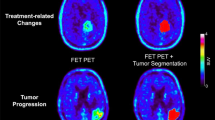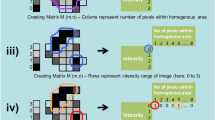Abstract
Purpose
Amino acid positron emission tomography (PET) with [18F]-fluoroethyl-L-tyrosine (FET) is well established in the diagnostic work-up of malignant brain tumors. Analysis of FET-PET data using tumor-to-background ratios (TBR) has been shown to be highly valuable for the detection of viable hypermetabolic brain tumor tissue; however, it has not proven equally useful for tumor grading. Recently, textural features in 18-fluorodeoxyglucose-PET have been proposed as a method to quantify the heterogeneity of glucose metabolism in a variety of tumor entities. Herein we evaluate whether textural FET-PET features are of utility for grading and prognostication in patients with high-grade gliomas.
Methods
One hundred thirteen patients (70 men, 43 women) with histologically proven high-grade gliomas were included in this retrospective study. All patients received static FET-PET scans prior to first-line therapy. TBR (max and mean), volumetric parameters and textural parameters based on gray-level neighborhood difference matrices were derived from static FET-PET images. Receiver operating characteristic (ROC) and discriminant function analyses were used to assess the value for tumor grading. Kaplan-Meier curves and univariate and multivariate Cox regression were employed for analysis of progression-free and overall survival.
Results
All FET-PET textural parameters showed the ability to differentiate between World Health Organization (WHO) grade III and IV tumors (p < 0.001; AUC 0.775). Further improvement in discriminatory power was possible through a combination of texture and metabolic tumor volume, classifying 85 % of tumors correctly (AUC 0.830). TBR and volumetric parameters alone were correlated with tumor grade, but showed lower AUC values (0.644 and 0.710, respectively). Furthermore, a correlation of FET-PET texture but not TBR was shown with patient PFS and OS, proving significant in multivariate analysis as well. Volumetric parameters were predictive for OS, but this correlation did not hold in multivariate analysis.
Conclusions
Determination of uptake heterogeneity in pre-therapeutic FET-PET using textural features proved valuable for the (sub-)grading of high-grade glioma as well as prediction of tumor progression and patient survival, and showed improved performance compared to standard parameters such as TBR and tumor volume. Our results underscore the importance of intratumoral heterogeneity in the biology of high-grade glial cell tumors and may contribute to individual therapy planning in the future, although they must be confirmed in prospective studies before incorporation into clinical routine.





Similar content being viewed by others
References
Louis DN, Ohgaki H, Wiestler OD, Cavenee WK, Burger PC, Jouvet A, et al. The 2007 WHO classification of tumours of the central nervous system. Acta Neuropathol. 2007;114(2):97–109.
Viaccoz A, Lekoubou A, Ducray F. Chemotherapy in low-grade gliomas. Curr Opin Oncol. 2012;24(6):694–701.
Cloughesy T. The impact of recent data on the optimization of standards of care in newly diagnosed glioblastoma. Semin Oncol. 2011;38 Suppl 4:S11–20.
Stupp R, Mason WP, van den Bent MJ, Weller M, Fisher B, Taphoorn MJ, et al. Radiotherapy plus concomitant and adjuvant temozolomide for glioblastoma. N Engl J Med. 2005;352(10):987–96.
Chaudhry NS, Shah AH, Ferraro N, Snelling BM, Bregy A, Madhavan K, et al. Predictors of long-term survival in patients with glioblastoma multiforme: advancements from the last quarter century. Cancer Investig. 2013;31(5):287–308.
Weiler M, Wick W. Molecular predictors of outcome in low-grade glioma. Curr Opin Neurol. 2012;25(6):767–73.
Scott JN, Brasher PM, Sevick RJ, Rewcastle NB, Forsyth PA. How often are nonenhancing supratentorial gliomas malignant? A population study. Neurology. 2002;59(6):947–9.
Gutman DA, Cooper LA, Hwang SN, Holder CA, Gao J, Aurora TD, et al. MR imaging predictors of molecular profile and survival: multi-institutional study of the TCGA glioblastoma data set. Radiology. 2013;267(2):560–9.
Weckesser M, Langen K, Rickert C. al. e. O-(2-[(18)F]fluoroethyl)-L-tyrosine PET in the clinical evaluation of primary brain tumours. Eur J Nucl Med Mol Imaging. 2005;32:422–9.
Dunet V, Rossier C, Buck A, Stupp R, Prior JO. Performance of 18F-fluoro-ethyl-tyrosine (18F-FET) PET for the differential diagnosis of primary brain tumor: a systematic review and metaanalysis. J Nucl Med. 2012;53(2):207–14.
Popperl G, Kreth FW, Mehrkens JH, Herms J, Seelos K, Koch W, et al. FET PET for the evaluation of untreated gliomas: correlation of FET uptake and uptake kinetics with tumour grading. Eur J Nucl Med Mol Imaging. 2007;34(12):1933–42.
Jansen NL, Graute V, Armbruster L, Suchorska B, Lutz J, Eigenbrod S, et al. MRI-suspected low-grade glioma: is there a need to perform dynamic FET PET? Eur J Nucl Med Mol Imaging. 2012;39(6):1021–9.
Jansen NL, Suchorska B, Wenter V, Schmid-Tannwald C, Todica A, Eigenbrod S, et al. Prognostic significance of dynamic 18F-FET PET in newly diagnosed astrocytic high-grade glioma. J Nucl Med. 2015;56(1):9–15.
Pyka T, Gempt J, Ringel F, Huttinger S, van Marwick S, Nekolla S, et al. Prediction of glioma recurrence using dynamic (1)(8)F-fluoroethyltyrosine PET. AJNR Am J Neuroradiol. 2014;35(10):1924–9.
Cheng NM, Fang YH, Chang JT, Huang CG, Tsan DL, Ng SH, et al. Textural features of pretreatment 18F-FDG PET/CT images: prognostic significance in patients with advanced T-stage oropharyngeal squamous cell carcinoma. J Nucl Med. 2013;54(10):1703–9.
Tixier F, Le Rest CC, Hatt M, Albarghach N, Pradier O, Metges JP, et al. Intratumor heterogeneity characterized by textural features on baseline 18F-FDG PET images predicts response to concomitant radiochemotherapy in esophageal cancer. J Nucl Med. 2011;52(3):369–78.
Cook GJ, Yip C, Siddique M, Goh V, Chicklore S, Roy A, et al. Are pretreatment 18F-FDG PET tumor textural features in non-small cell lung cancer associated with response and survival after chemoradiotherapy? J Nucl Med. 2013;54(1):19–26.
Tixier F, Hatt M, Valla C, Fleury V, Lamour C, Ezzouhri S, et al. Visual versus quantitative assessment of intratumor 18F-FDG PET uptake heterogeneity: prognostic value in non-small cell lung cancer. J Nucl Med. 2014;55(8):1235–41.
Lutz K, Radbruch A, Wiestler B, Baumer P, Wick W, Bendszus M. Neuroradiological response criteria for high-grade gliomas. Clin Neuroradiol. 2011;21(4):199–205.
Popperl G, Kreth FW, Herms J, Koch W, Mehrkens JH, Gildehaus FJ, et al. Analysis of 18F-FET PET for grading of recurrent gliomas: is evaluation of uptake kinetics superior to standard methods? J Nucl Med. 2006;47(3):393–403.
Orlhac F, Soussan M, Maisonobe JA, Garcia CA, Vanderlinden B, Buvat I. Tumor texture analysis in 18F-FDG PET: relationships between texture parameters, histogram indices, standardized uptake values, metabolic volumes, and total lesion glycolysis. J Nucl Med. 2014;55(3):414–22.
Amadasun M, King R. Textural features corresponding to textural properties. IEEE Trans Syst Man Cybern. 1989;19(5):1264–74.
Budczies J, Klauschen F, Sinn BV, Gyorffy B, Schmitt WD, Darb-Esfahani S, et al. Cutoff finder: a comprehensive and straightforward Web application enabling rapid biomarker cutoff optimization. PLoS One. 2012;7(12), e51862.
Bender R, Lange S. Adjusting for multiple testing—when and how? J Clin Epidemiol. 2001;54(4):343–9.
Brooks FJ, Grigsby PW. The effect of small tumor volumes on studies of intratumoral heterogeneity of tracer uptake. J Nucl Med. 2014;55(1):37–42.
Ganeshan B, Goh V, Mandeville HC, Ng QS, Hoskin PJ, Miles KA. Non-small cell lung cancer: histopathologic correlates for texture parameters at CT. Radiology. 2013;266(1):326–36.
Little SE, Popov S, Jury A, Bax DA, Doey L, Al-Sarraj S, et al. Receptor tyrosine kinase genes amplified in glioblastoma exhibit a mutual exclusivity in variable proportions reflective of individual tumor heterogeneity. Cancer Res. 2012;72(7):1614–20.
van Velden FH, Cheebsumon P, Yaqub M, Smit EF, Hoekstra OS, Lammertsma AA, et al. Evaluation of a cumulative SUV-volume histogram method for parameterizing heterogeneous intratumoural FDG uptake in non-small cell lung cancer PET studies. Eur J Nucl Med Mol Imaging. 2011;38(9):1636–47.
Tixier F, Hatt M, Le Rest CC, Le Pogam A, Corcos L, Visvikis D. Reproducibility of tumor uptake heterogeneity characterization through textural feature analysis in 18F-FDG PET. J Nucl Med. 2012;53(5):693–700.
Compliance with Ethical Standards
This study was supported by funding from the German Research Foundation DFG (grant to SF: FO 886/1-1) and from the Faculty of Medicine of the Technical University of Munich (grant to TP: KKF B11-14). The authors declare that they have no conflict of interest. The retrospective study was approved by the local ethics committee (registration number: 5626/12). All procedures performed involving human participants were in accordance with the ethical standards set forth by the institutional and/or national research committee and with the 1964 Declaration of Helsinki and its later amendments or comparable ethical standards. Informed consent was obtained from all individual participants included in the study as part of clinical routine.
Author information
Authors and Affiliations
Corresponding author
Additional information
Thomas Pyka and Jens Gempt contributed equally to this work.
Rights and permissions
About this article
Cite this article
Pyka, T., Gempt, J., Hiob, D. et al. Textural analysis of pre-therapeutic [18F]-FET-PET and its correlation with tumor grade and patient survival in high-grade gliomas. Eur J Nucl Med Mol Imaging 43, 133–141 (2016). https://doi.org/10.1007/s00259-015-3140-4
Received:
Accepted:
Published:
Issue Date:
DOI: https://doi.org/10.1007/s00259-015-3140-4




